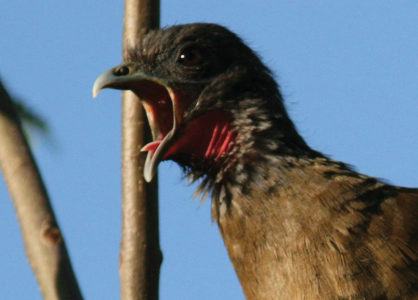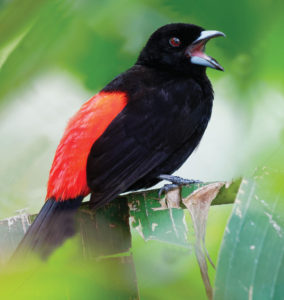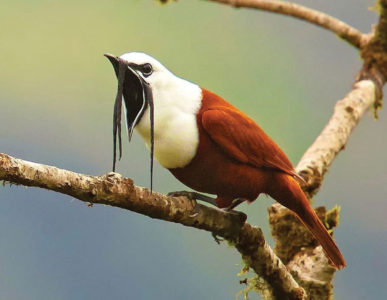Birds
There have been some unexpected and odd changes in our little part of the jungle since this whole pandemic thing started. Especially with our feathered friends the birds. Six different types of birds were hanging together peacefully in the tree next to my porch the other day instead of squabbling with each other. Lately a bunch of scarlet macaws have taken up residency here in Dominical, and while they are quite beautiful, they are also incredibly loud and obnoxious. But they clearly love to talk to each other. It seems all our local critters have been affected. According to the folks who monitor such things, there are now 4 times as many little baby turtles making it across the treacherous beaches to launch themselves into the ocean. We’ve had a rare kinkajou hanging out in town recently, monkeys venturing into parts of Dominical where they have never ventured before and a couple of crocs lurking around the mouth of the river. My friend Linda has seen mountain lions – pumas – on the trail cam by her house and I can clearly hear the ocean from my bed and the soft sounds of night time in the jungle.
Few cars. Even fewer noisy semi-trucks. No tourists, so no car alarms or late night disco or techno crap drowning out the natural sounds. No kids singing the national anthem at the school next door…. But, there are no music gigs, the bartenders and chefs and tour guides and teachers are out of work and everyone seems to blame the other guys
 Every once in a while I’ll be rudely jolted out of a blissful sleep at like 5 in the freaking morning by the incredibly loud call/song/RACKET being produced by what I call the Maniacal bird. He mostly hangs out under dense foliage, and apparently likes to walk and talk right by my bedroom window. He’s got this raspy, rusty-hinge kind of voice for part of his call, then a weird whoop whoop thing and tops it off with a long anguished note that can wake the proverbial dead. It’s not quite as obnoxious as Woody Woodpeckers cackle in the old cartoons, but it’s definitely in the same category. I finally saw him one morning, traveling on the ground under a papaya tree and a tangle of hibiscus, and he is about a foot tall, has a long skinny neck, he’s shades of non-descript brown and a pretty clumsy flyer. I looked him up in my tattered bird bible, A Guide to the Birds of Costa Rica, and he’s called a Chachalaca. Boom cha cha laca laca, boom cha cha laca laca. (Anybody remember Sly and the Family Stone?) Anyway, de-forestation of his habitat is taking its toll, and some species in his family are on a fast track to extinction—which would be a horrible thing ‘cause to tell ‘ya the truth I’ve come to enjoy his boisterous concerts, which is kinda like saying you like the sound of bagpipes or fingernails on a chalkboard.
Every once in a while I’ll be rudely jolted out of a blissful sleep at like 5 in the freaking morning by the incredibly loud call/song/RACKET being produced by what I call the Maniacal bird. He mostly hangs out under dense foliage, and apparently likes to walk and talk right by my bedroom window. He’s got this raspy, rusty-hinge kind of voice for part of his call, then a weird whoop whoop thing and tops it off with a long anguished note that can wake the proverbial dead. It’s not quite as obnoxious as Woody Woodpeckers cackle in the old cartoons, but it’s definitely in the same category. I finally saw him one morning, traveling on the ground under a papaya tree and a tangle of hibiscus, and he is about a foot tall, has a long skinny neck, he’s shades of non-descript brown and a pretty clumsy flyer. I looked him up in my tattered bird bible, A Guide to the Birds of Costa Rica, and he’s called a Chachalaca. Boom cha cha laca laca, boom cha cha laca laca. (Anybody remember Sly and the Family Stone?) Anyway, de-forestation of his habitat is taking its toll, and some species in his family are on a fast track to extinction—which would be a horrible thing ‘cause to tell ‘ya the truth I’ve come to enjoy his boisterous concerts, which is kinda like saying you like the sound of bagpipes or fingernails on a chalkboard.
Here in Costa Rica, and especially along the southern Pacific coast and nearby mountains, we are treated to a daily symphony of bird noises, from the rhythmic head-banging of a Woodpecker to repetitive trills from the soprano section to elaborate 3 part songs. No kidding–a bunch of birds structure their songs just like us human musicians, with an A part, a B part and a repeat of the A part. I’ve also heard them do AABA, and ABBA and ABCA, just like we do. Birdbrains unite! Then a couple dozen Parakeets will chime in for the chorus part. The only time it’s truly quiet around my house is in the mid afternoon in dry season. In areas of sparse vegetation (or during the dry season) the birds are able to see each other more easily, so aren’t using their voices to locate each other as often. But a morning in mating season almost requires ear-plugs! There’s a scarlet-rumped tanager in my yard who sings a melody in 4/4 time. 1, 222, 3, 4… 1, 222, 3, 4… cool triplet and note change on the second beat. Including Coco’s Island and the nearby Pacific, Costa Rica has 850 species of birds! 600 of them are permanent residents, and there are 200 species of migrant birds who come to CR each year, some from as far away as New Zealand, Antarctica and Siberia. They’re probably just here getting new music ideas…
 Birds rely on repeated patterns, scales, arpeggios, themes and variations, again much like classical composers or rock musicians. Scientist types group them as songs or calls. Calls are more like alarms or ways to keep members of a flock in contact with each other. Songs are longer and more complex and are associated with courtship and mating, so there’s probably an electric guitar involved. In the tropics it is more common for females to sing as much as the males, so we get to hear the whole conversation! Some birds here produce a hissing sound (especially those who nest in tree cavities or hidden crannies) that presumably helps to deter predators or maybe electric guitar players.
Birds rely on repeated patterns, scales, arpeggios, themes and variations, again much like classical composers or rock musicians. Scientist types group them as songs or calls. Calls are more like alarms or ways to keep members of a flock in contact with each other. Songs are longer and more complex and are associated with courtship and mating, so there’s probably an electric guitar involved. In the tropics it is more common for females to sing as much as the males, so we get to hear the whole conversation! Some birds here produce a hissing sound (especially those who nest in tree cavities or hidden crannies) that presumably helps to deter predators or maybe electric guitar players.
For hundreds of years composers have incorporated bird songs into their pieces. Mozart threw a lavish funeral for his pet Starling, a bird which has two vocal cords and can sing 2 melodies at the same time. He wrote one piece that was nick-named The Musical Joke, as most folks thought it awkward and slightly off-key—they didn’t understand the complexity and welcome imperfections of the source, which are bird songs. Beethoven’s 6th Symphony quotes the song of a Yellowhammer bird, followed by a Quail then a Cuckoo—the bird used in more musical imitations than any other. A Goldfinch inspired Vivaldi’s flute concerto Il Gardellino, and Prokofiev featured a bunch of different birds in his great composition Peter and the Wolf. Handel wrote an organ concerto called The Cuckoo and the Nightingale, using the different stops and settings on the organ to mimic his feathered friends. Seems like in just about every time frame and culture some mystic was writing a song about a bird, from Indian monks to American Indian medicine men, from Celtic folk songs to Jimi Hendrix\, and from Baroque guys in white wigs to the Grateful Dead.
 Several years ago Costa Rican pianist and Minister of Culture, Manuel Obregon, carried his piano into a rainforest near Arenal and played along with the birds and insects and monkeys and such. Most ‘nature’ recordings are just that—recordings of natural sounds augmented in the studio with instruments or vocals. Not Manuel, he played and recorded the critters and himself all day long for 3 days, then placed the selected parts in chronological order—morning, afternoon, dusk and night. Get the cd—it’s called Simbiosis—and you will be amazed at the duets Manuel played with some of the birds. It is obvious they were aware of him and had something to discuss with him. I’m thinkin’ if we’d all just spend some time listening to their calls and their songs, we’d be bound to learn something about global harmony.
Several years ago Costa Rican pianist and Minister of Culture, Manuel Obregon, carried his piano into a rainforest near Arenal and played along with the birds and insects and monkeys and such. Most ‘nature’ recordings are just that—recordings of natural sounds augmented in the studio with instruments or vocals. Not Manuel, he played and recorded the critters and himself all day long for 3 days, then placed the selected parts in chronological order—morning, afternoon, dusk and night. Get the cd—it’s called Simbiosis—and you will be amazed at the duets Manuel played with some of the birds. It is obvious they were aware of him and had something to discuss with him. I’m thinkin’ if we’d all just spend some time listening to their calls and their songs, we’d be bound to learn something about global harmony.
You just might be inspired to write a song about them. Or steal some licks from them. Whether you think they are ‘divine messengers from the deities’ (as the ancient Egyptians did) or just pigeons carrying a note across town for food, they are interesting and beautiful and mysterious and have much to teach us about singing.
I used to nag you folks about getting out and listening to live music, but since we don’t have that option right now I suggest you find a comfy hammock near some trees and listen to the birds! Maybe we’ll learn something about global harmony! Thanks for reading – I may cut back to an article every other month, but all us musicians hope you won’t forget about us! Bottom line is we play for you folks – it ain’t for the birds!
The early bird gets the worm, but the second mouse gets the cheese. Willie Nelson
Birds…scream at the top of their lungs in horrified hellish rage every morning at daybreak to warn us all of the truth. They know the truth! Screaming bloody murder all over the world in our ears, but sadly we don’t speak bird. Kurt Cobain
Little birdie come and sing me your sad song. We’ve a short time to stay here and a long time to be gone.
John Cunnick


